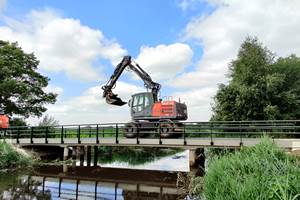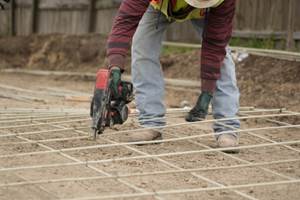Prefabricated Bridge Elements and Systems: An opportunity for composites
The Federal Highway Admin. (FHWA) is keenly aware of the disruptions that highway and bridge projects impose on the traveling public. To address this need, the FHWA rolled out a series of accelerated bridge construction (ABC) initiatives. One involves prefabricated bridge elements and systems — a need the composites industry can easily meet.
The Federal Highway Admin. (FHWA) is keenly aware of the disruptions that highway and bridge projects impose on the traveling public. According to the Texas Transportation Institute’s (TTI) Urban Mobility Report, published in 2007, more than 4 billion hours per year and 3 billion gal (11.36 billion liters) of fuel are wasted by commuters sitting in traffic due to construction delays. Over the years, traffic volumes have increased exponentially. Further, such activities are likely to increase due to much-needed bridge reconstruction. Of the roughly 600,000 bridges in the U.S. inventory, approximately 25 percent are classified as “structurally deficient or functionally obsolete,” meaning that repair or replacement is an ongoing need. These facts underscore for transportation officials the need to maintain a transportation network that is impeded as little as possible by construction activity. To address this need, the FHWA rolled out a series of accelerated bridge construction (ABC) initiatives under the purview of the Every Day Counts (EDC) program.
Launched in fall 2010, EDC is a collaborative effort that involves the FHWA, the American Association of State Highway and Transportation Officials (AASHTO), state departments of transportation (DOTs), local agencies, and industry to work on ways to reduce overall project delivery time and the mobility and safety impacts that are created due to onsite construction. EDC participants recognize that a meaningful improvement will require a paradigm shift in highway construction techniques. Traditional construction methods will need to give way to different approaches. Among the many ABC alternatives, which include better planning, fee structure changes and greater right-of-way and utility flexibilities, EDC is generating interest in a construction concept called Prefabricated Bridge Elements and Systems, or PBES.
PBES are key enabling technologies that can reduce overall project delivery time through ABC. Bridge projects that have historically created traffic congestion for one, two or even more construction seasons can be done, if prefabrication opportunities are taken, in such a way that traffic disruptions can be minimized to weeks or even weekends. The use of PBES is so effective that it is the FHWA’s goal to see it become the mainstream method of bridge construction. Although conventional construction methods, such as cured-in-place concrete, will continue where appropriate, they will no longer be the methods of choice.
PBES include not only the structural components of a bridge that can be built at remote offsite locations but also those that can be constructed without traffic disruption adjacent to highway construction sites. They include features that reduce onsite construction time, reduce the impact on motorist mobility and safety, and enhance worker safety. Examples of prefabricated elements include full-depth precast deck panels, steel grid decks, aluminum deck panels, modular beams with decks, full-width beams, prefabricated truss spans, precast segmental spans, pier elements, abutment and wall solutions and miscellaneous items, such as prefabricated parapets and approach slabs. Prefabricated systems also could include preassembled superstructures or complete prefabricated bridges. Clearly, EDC collaborators are looking at a broad range of materials that are available to meet the prefabricated objective — including traditional concrete and steel materials as well as composites.
Throughout the U.S., state DOTs are implementing the EDC initiatives. So far, hundreds of bridges have been designed or constructed rapidly using PBES concepts. The national EDC goal for PBES implementation is that 25 percent of bridge projects authorized with federal aid funds will include at least one major prefabricated bridge element. PBES technologies that DOTs are selecting in their ABC projects include, among many things, more efficient beam shapes, full-depth deck panels, pier caps and columns, and partial-depth deck panels.
The FHWA is seeking ways to advance PBES concepts and is actively reaching out to the transportation industry for assistance and innovative ideas. Anyone who wants to get involved in the EDC initiative can visit the FHWA Web site (www.fhwa.dot.gov/bridge/abc/) to find resources that explain ABC, PBES and other solutions that are now being implemented by state DOTs. One new resource is a free, downloadable ABC manual titled Accelerated Bridge Construction: Experience in Design, Fabrication and Erection of Prefabricated Bridge Elements and Systems. It provides an overview of the current state of practice, construction materials and construction concepts. It also includes ABC success stories. There also is an extensive library of reports about PBES design and its use over the past decade. The FHWA is planning future publications that will demonstrate in greater detail how PBES is integrated with project planning, engineering and contracting. Visitors also have access to a series of ongoing webinars, and workshops and peer-to-peer exchanges are continually held to promote the increased use of PBES.
The FHWA is looking to the composites industry for ideas and is working with the American Composites Manufacturers Assn.’s (ACMA) Transportation Structures Council to educate DOT officials and engineers about the value and benefits that composites bring to the market, through regional Peer-to-Peer Workshops. The FHWA encourages composites industry professionals to find out more about FHWA’s initiative and ACMA activities and to reach out to their state and local transportation agencies with innovations that reduce on-site construction time, minimize mobility impacts, increase safety for workers and the traveling public and reduce environmental impacts. For more information, please visit www.fhwa.dot.gov/everydaycounts/index.cfm and www.acmanet.org/dac/tsc.cfm.
Related Content
Refurbishing bridges at half the time, cost versus replacement
Instead of demolishing and rebuilding bridges, SUREbridge doubles the strength and durability of existing structures with an FRP deck for a smart, sustainable solution.
Read MoreGatorbar, NEG, ExxonMobil join forces for composite rebar
ExxonMobil’s Materia Proxima polyolefin thermoset resin systems and glass fiber from NEG-US is used to produce GatorBar, an industry-leading, glass fiber-reinforced composite rebar (GFRP).
Read MoreMaterials & Processes: Resin matrices for composites
The matrix binds the fiber reinforcement, gives the composite component its shape and determines its surface quality. A composite matrix may be a polymer, ceramic, metal or carbon. Here’s a guide to selection.
Read MoreMaterials & Processes: Composites fibers and resins
Compared to legacy materials like steel, aluminum, iron and titanium, composites are still coming of age, and only just now are being better understood by design and manufacturing engineers. However, composites’ physical properties — combined with unbeatable light weight — make them undeniably attractive.
Read MoreRead Next
From the CW Archives: The tale of the thermoplastic cryotank
In 2006, guest columnist Bob Hartunian related the story of his efforts two decades prior, while at McDonnell Douglas, to develop a thermoplastic composite crytank for hydrogen storage. He learned a lot of lessons.
Read MoreComposites end markets: Energy (2024)
Composites are used widely in oil/gas, wind and other renewable energy applications. Despite market challenges, growth potential and innovation for composites continue.
Read MoreCW’s 2024 Top Shops survey offers new approach to benchmarking
Respondents that complete the survey by April 30, 2024, have the chance to be recognized as an honoree.
Read More



.jpg;maxWidth=300;quality=90)


















